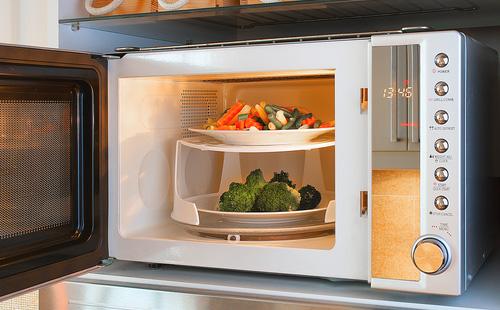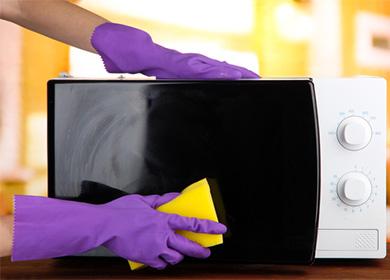The content of the article
A microwave oven, according to modern housewives, is an indispensable assistant in the kitchen. Indeed, it is difficult to cope without it: you have to warm up lunch or dinner on the stove, and this is an additional dirty dishware plus an extra waste of time. In the microwave, they not only warm dishes: they use it to defrost semi-finished products, they cook food in it. Naturally, the active use of the device leads to the fact that it quickly becomes dirty.
Cleaning rules
Caring for household appliances prolongs their life. The microwave must be cleaned regularly, but it is important to do it correctly. Remember the five rules before proceeding with cleaning.
- Turn it off. Household appliances are cleaned only after disconnecting them from the power supply. This is a safety precaution, failure to observe which may result in electric shock.
- No to metal and abrasives. Metal washcloths / brushes are not suitable for microwave cleaning. They can damage the coating, which reflects the waves, resulting in damage to the device. Metal particles may remain inside and ignition will occur. Purchased cleaning abrasives do not fit: they scratch the coating. Use exceptionally soft rags and liquid detergents.
- Less fluid. There are elements in the microwave that are not desirable to get moisture on. Use a minimum of liquid during cleaning, so as not to accidentally fill the “sensitive” elements.
- Cleaning from all sides. It is necessary to clean not only the "inside" of the microwave oven, but also its external parts. Pay close attention to the grill on the back of the appliance: there is usually a lot of dirt and dust accumulating there. However, aggressive household products cannot be used not only inside, but also outside.
- Do not disassemble. Did you see that the impurities penetrated deep inside the device, and the idea was to disassemble the furnace? This is strictly prohibited by safety precautions. Even if you manage to disassemble and assemble the device, it can explode when turned on.

How to clean a microwave without chemistry: proven methods
Folk remedies are not inferior to convenience stores in terms of effectiveness, and sometimes they even cope with tasks better than purchased liquids. Another plus in favor of popular methods of cleaning household appliances is safety.
Use what is in every kitchen: prepare vinegar, lemon, soda solutions. How to wash the microwave from fat with their help? Most methods involve steam cleaning: by creating a steam bath using washing solutions, you can clean the microwave without any effort, and even in a matter of minutes.
Steam bath
Features If you regularly clean the microwave, and there is no accumulation of fat on its walls, then to prevent pollution and to combat minimal stains, it is enough to take only water. You do not have to wash the appliance thoroughly: you need liquid to create a steam bath.
Start cleaning
- Pour liquid into dishes that can be used in the microwave.
- Boil for 10 minutes (power should be maximum).
- Wipe the walls of the appliance with a soft cloth.

Vinegar solution
Features Acetic acid will help to clean the microwave inside to the state of “only purchased appliance”. Its action is aimed at softening fat. This is the most affordable way, because such a “cleaning agent” is stored by each housewife on a shelf.
Start cleaning
- In a plate suitable for use in a microwave, prepare an aqueous-vinegar solution. On a glass of liquid you need to take two tablespoons of vinegar.
- Place the solution in the microwave for five minutes.
- Select maximum power mode.
- Do not open the door immediately after the signal: wait 10 minutes.
- Wipe the walls of the device with a cloth moistened in acetic solution.
Citrus
Features Orange or lemon peels will help to cope with the most difficult pollution. Therefore, before trying to clean the microwave from carbon deposits using chemistry, try this method.
Start cleaning
- In a container that can be used in a microwave oven, place the citrus peels and fill them with liquid.
- Put everything in the microwave, turn on the maximum mode for seven minutes.
- After the beep, do not open the door for another 15 minutes.
- Wipe the walls of the appliance with a soft sponge.
The reviews of the hostesses confirm that the result after such a cleaning is amazing. What's the secret? Why do citrus peels even cope with impurities that not every chemical product can cope with? Everything is simple. During a steam bath, citrus essential oils, which dissolve fat, settle on the walls of the microwave. An indisputable plus of this method is the citrus aroma, which refreshes not only the microwave, but also deodorizes the entire apartment.

Soda Cleaning
Features Soda perfectly cleans and disinfects surfaces. You can tidy up the microwave with a soda solution in literally ten minutes. This housewife must take this recipe into service: it will help out when the guests are on the doorstep, and I want everything to shine.
Start cleaning
- In a half-liter container, make a soda-water mixture: take 0.5 tablespoon of liquid to take a tablespoon of sodium bicarbonate.
- If the dirt is old, strengthen the solution with two tablespoons of acetic acid.
- Heat the solution at maximum power for five minutes.
- Leave as much after the signal.
- Wipe the stove.
Soap solution
Features To deal with contaminants that remain in the microwave after cooking / heating food, optionally using a steam bath. Laundry soap will help to quickly clean the equipment.
Start cleaning
- Foam the soap.
- Pour soap solution into the spray bottle.
- Spray the product onto the walls of the microwave.
- After half an hour, wipe the inside of the appliance with a damp sponge.

We remove the smell of burning
Acetic, soap, soda solution and other popular microwave cleaning methods do a good job of contaminants, however, they are not always able to remove odors. These folk remedies have a slight deodorizing effect: in fact, they simply refresh. If something is burnt in the microwave, solutions are not always effective. Then get rid of the burning smell in the microwave will help one of four methods, repeatedly tested by the hostesses.
Odorous herbs
Features If the house has Melissathyme lavender, then it will be easy for you to remove the smell of burning from the microwave, even if it is strong. As a result, not only household appliances, but the whole kitchen will smell pleasantly.
Start cleaning
- Place the herbs in the microwave container and fill with tap water.
- Boil for 25 minutes. Power is maximum.
- After the signal, do not rush to take out the herbs: leave for another half hour.
- Get a container with herbs, and instead put a bowl of salt or coffee. Let the bowl stand in the microwave for a couple of days. Naturally, do not use the appliance at this time.
Lemon Juice and Dishwashing Detergent
Features Citrus fruits effectively cope with dirt and odors in the microwave. But what if the burning smell is so strong that it even comes out through the citrus aroma? Do not rush to clutch at aggressive means: strengthen the effect of lemon with a dishwashing solution.
Start cleaning
- Prepare a foaming solution. A dishwashing detergent will need just a couple drops in a glass of liquid.
- Add lemon juice (about two teaspoons) to the solution.
- Put in the microwave at full power for 10 minutes.
- After the signal, remove the container. Do not close the microwave door for a day - let it air.
Salt and Activated Carbon
Features In the fight against odors, you need to use substances that have the ability to absorb aromas. Surprising housewives who are trying to get rid of the smell of burning in the stove is capable of a tandem of salt and activated carbon.
Start cleaning
- Pour salt into a deep bowl.
- Add crushed activated carbon (15 tablets).
- Leave the bowl in the microwave overnight. The door must be closed. By morning, there will be no trace of smell.

Toothpaste
Features If the smell of burning does not allow normal use of the device, toothpaste will be another way to combat it. True, it should be menthol.
Start cleaning
- Squeeze the paste onto a damp sponge (do not overdo it, it will be difficult to remove a large amount of paste later).
- Wipe the inside of the appliance.
- After half an hour, rinse the surfaces with foamed detergent.
Prevention is easier than fix: 3 tips for cleanliness
If the microwave is very dirty, then it will be difficult to return to its proper form. Usually you have to turn to several cleaning methods, and this is a loss of time and effort. Do not allow the deplorable state of household appliances.Follow the three tips for caring for your microwave, and it will always delight you with cleanliness.
- Regular cleaning. Even if you think the microwave is clean, wipe it at least once a week. Once a month, a preventive steam procedure is recommended. You may not even add a solution.
- Splash prevention. In the process of heating, splashes appear on the walls of the device. It is easy to prevent this: buy a special cap that covers the containers during heating in the microwave. The hood is much easier to wash than the entire microwave.
- Remove the consequences of the "explosion". Slices of food and fat from the "exploded" food must be removed immediately. If this is not done, then the pollution will dry up and deal with them will not be so easy. In addition, traces of the "explosion" are the cause of an unpleasant odor in the device.
Exterior Care
Sometimes housewives forget that it is necessary to wash not only the inner walls, but also the outer part of the stove. If on the handle, sides and other parts there is no strong pollution, then it is enough to walk on them with a damp cloth once a week. Are oily fingerprints visible? Conventional dishwashing detergent and a soft sponge will come to the rescue.
If you need to quickly wash the microwave from the fat from the outside, and he ate it - the soda solution will help (as for a steam bath): apply it with a sponge, let it stand for ten minutes, wash the body. To remove dirt in the seams and near the buttons, moisten cotton swabs in a soda solution and walk through hard-to-reach spots. Do not forget to clean the back wall sometimes: the accumulation of dirt and dust here can affect the operation of the device.

